#USS Salt Lake City (CA-25)
Explore tagged Tumblr posts
Photo



B-25s fly over USS Salt Lake City (CA-25) at the start of the Doolittle Raid, 18 April 1942
244 notes
·
View notes
Text
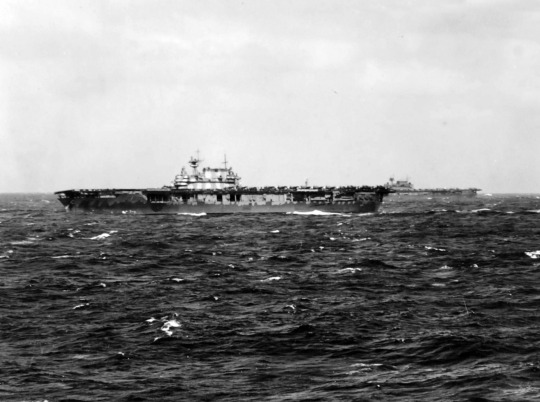
"USS HORNET (CV-8) and USS ENTERPRISE (CV-6) underway during the Doolittle Raid, in April 1942. The photo was (obviously) taken after the U.S. Army Air Forces North American B-25 Mitchell bombers had taken off from Hornet, as aircraft of her own air group are now on deck."
The photo was taken from the heavy cruiser USS SALT LAKE CITY (CA-25).
U.S. Naval History and Heritage Command: 80-G-324201
#USS Hornet (CV-8)#USS Hornet#USS Enterprise (CV-6)#USS Enterprise#Yorktown Class#aircraft carrier#warship#ship#Doolittle Raid#Pacific Ocean#World War II#World War 2#WWII#WW2#united states navy#us navy#navy#usn#u.s. navy#my post
107 notes
·
View notes
Text
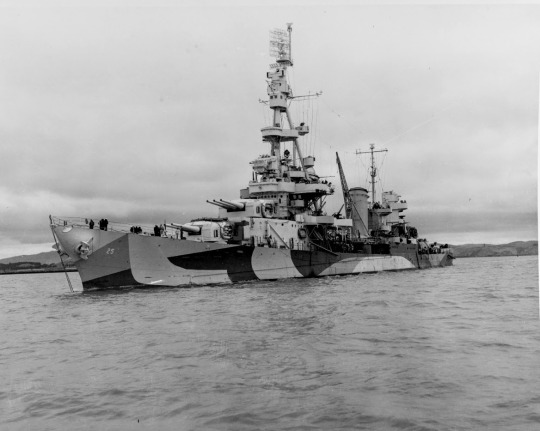
(6/21/1944) USS Salt Lake City (CA-25)
Off the Mare Island Navy Yard, . Photograph from the Bureau of Ships Collection
21 notes
·
View notes
Photo

USS Salt Lake City (CA-25) off Mare Island Naval Shipyard, 21 June 1944
50 notes
·
View notes
Photo

“Forward plan view of the USS Salt Lake City (CA-25) at Mare Island Navy Yard on 10 May 1943. U.S. Navy Photo #3550-43.”
(Source)
#Military#History#USS Salt Lake City#Heavy cruiser#United States Navy#US Navy#WWII#WW2#Pacific War#World War II
129 notes
·
View notes
Video
youtube
USS Pensacola (CA-24) to jeden z dwóch krążowników klasy Pensacola. USS Pensacola (CA-24) został zwodowany w 1929 roku i wprowadzony do słu��by w 1939 roku. Drugim krążownikiem klasy Pensacola był USS Salt Lake City (CA-25). USS Pensacola (CA-24) do 1941 roku pływał na Pacyfiku i Karaibach. 29 listopada opuścił Pearl Harbor z konwojem (Pensacola Convoy) do Manilii na Filipinach. Po wybuchu wojny został on przekierowany do Australii. Do 1945 roku brał aktywny udział w walkach na Pacyfiku. W 1943 roku został poważnie uszkodzony w Bitwie pod Tassafaronga. Po wojnie wziął udział jako okręt testowy w Operacji Crossroads (1946). Okręt przetrwał dwa wybuchy nuklearne. Po wykorzystaniu go do badań radiologicznych został zatopiony w 10 lutego 1948 roku w pobliżu wybrzeża Stanu Waszyngton.
0 notes
Note
favorite maritime anecdotes?
Here’s fifteen
1. “Somewhere during this period, I came across another small, telling anecdote that reveals more about the spirit of the destroyer’s crew. After the bombing in the Flores Sea, Houston lost not only her number three turret, cold storage locker, and crew’s head as well as three searchlights and two motor launches; her laundry was also destroyed. At that point the men of Edsall volunteered to provide laundry service for the cruiser. Bob Fulton told me that the last time he saw Edsall was when his clothes were being lowered over the port side of Houston’s quarterdeck to the destroyer. As he put it, “I don’t know where that brave ship is today, but wherever she is, my clothes are still aboard.””
–A Blue Sea of Blood: Deciphering the Mysterious Fate of the USS Edsall, by Donald M. Kehn
2.

3.
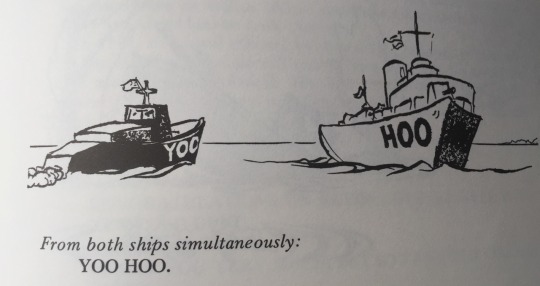
4. “On one of those raids the steering wheel [of USS Salt Lake City CA-25], loosened by the jar of the firing, fell off. The helmsman held it up in his two hands. And he turned to the captain with deference. “Sir,” he said, “what do I do with this now?” “Switch steering to auxiliary steering aft,” ordered the sweating Captain. The crew fell into a certain nonchalance about combat. At Saipan the officer of the deck accepted a line from a tanker and started fueling while an air attack was going on at an island two miles away. During one bombardment some genius of the commissary discovered caviar left over from a gala in San Francisco a year before. Officers off duty munched it in the wardroom while the guns roared. Off Okinawa, Poncho Miller, the boss of the lookouts, reported calmly, “Jap Betty (a bombing plane) is directly overhead.” “Signal it to keep going,” was the reply. “
5. From Enterprise, by Barrett Tillman (the practice was for escorting destroyers to rescue shot down pilots, and they’d bring them back to the carrier in exchange for five gallons of ice-cream, for carriers had icecream makers, but for the most part destroyers did not,)


6. “An ensign who graduated from the Naval Academy during Hart’s tenure as superintendent was considerably unnerved when he heard that Hart was the admiral who was coming to inspect his ship. When Hart came into the bridge, he seemed just as formidable as ever and, to test the alertness of the engine-room crew, he walked over to the voice tube and shouted into it: “If eggs are five cents apiece, how much would a dozen cost?” To the horror of the ensign, the reply came back: “Shut up, you dumb son of a bitch, don’t you know we’re being inspected?” Hart showed just a twitch at the corners of his mouth. “They are alert,” he announced.”
— A Different Kind Of Victory: A Biography of Admiral Thomas C. Hart, by James Leutze
7. “Lt. (j.g.) John J. A. “Jack” Michel of Pope had grabbed the final boat back to his destroyer after getting his “fill” of San Miguel beer at the Army-Navy Club. He expected, with no pleasure, that his ship would again be conducting minefield patrols again the following week. Weather conditions on Manila Bay that night were typical according to Michel: “sticky [and] breathless.” He eventually fell asleep in his sweltering miniature stateroom, in spite of its dysfunctional ventilator and location next to the forward fire room. In the middle of that momentous night—and no doubt still damp with beery perspiration—he was awakened from his slumbers to be told, “I don’t suppose you’re particularly interested right now, but Pearl Harbor was bombed and we’re at war with Japan.” Michel could only mumble, “The bastards,” before going right back to sleep.”
— In The Highest Degree Tragic: The Sacrifice of the U.S. Asiatic Fleet during World War II, by Donald M. Kehn
8. From Signals from the Falklands, by John Winton
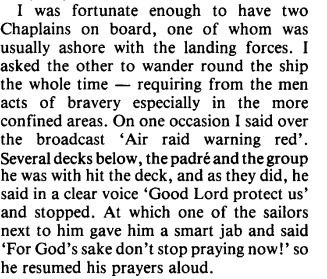
9. “Lieutenant Pat McEntee in the Atlanta witnessed it: a Wildcat closing fast on a Betty from behind. The fighter was evidently out of ammunition, for its driver resorted to an unusual tactic. Down came his landing gear. Down went his airspeed. It looked to McEntee as if he was trying “to set his ship down on the bomber’s broad back. And he did—again and again, and again, with sledgehammer impact. He literally was pounding the enemy into the sea with his wheels.” The bomber pilot had no escape. If he tried to pull up, it only increased the force of the impacts. Any evasive turn was easily matched by the agile fighter. “The only course open led down. But before the Jap could make a decision, something snapped under the pounding and the bomber plunged beneath the waves of Savo Sound.”
- James D. Hornfischer, Neptune’s Inferno: The U.S. Navy at Guadalcanal
10. “The first time the South Dakota’s main battery was tested with a full nine-gun broadside, the wave of blast pressure pushed through the passageway where Captain Thomas Gatch was standing, tearing his pants right off him. The vast power of the sixteen-inch guns required a perfect physical apparatus to ensure not only their working order but also the safety of the ship.”
-Neptune’s Inferno: The U.S. Navy at Guadalcanal, by James D. Hornfischer
11. “Electrician’s Mate John J. Kellejian’s battle station on the flag bridge often put him beside the task force commander. During a general quarters emergency drill there was little to do in flag country, prompting Halsey to ask Kellejian if he played cribbage. The youngster had never heard of it so the admiral exclaimed, “Don’t worry about it, son. I’ll teach you.” After a tutorial, Halsey declared the electrician ready to play, the stakes being a nickel a round. “I lost my ass,” Kellejian said, losing more than fifty games, but since sailors never had much money, the admiral seemed to forget the debt. Following Halsey’s death in 1959, Kellejian—long out of the Navy—received a summons from the admiral’s estate, demanding payment of a debt of $ 2.80. Kellejian phoned Halsey’s sister, who explained that Wild Bill had carried the amount as a joke to share with friends. The debt was forgiven, but John Kellejian kept the summons as a souvenir of his costly lessons at the knee of Admiral William F. Halsey.“–Enterprise, by Barrett Tillman
12. "Early that morning, the convoy came under attack from the USS Sturgeon, a submarine which fired a salvo of torpedoes and was rewarded with some satisfying explosions. These prompted the facetious signal “Sturgeon no longer virgin.” As no Japanese ship was actually penetrated, this claim was premature. So was the ejaculation of large numbers of torpedoes that night by the four old but dashing destroyers of Rear Admiral William A. Glassford’s Task Force 5, US Asiatic fleet, alerted by air reconnaissance from Java.”
–The Pacific Campaign, by Dan van der Vat
13. “USS Overton (DD-239), with two boilers inoperative, was sent to meet the speedy Queen Elizabeth 500 miles at sea, and escort her to port. Running her best speed in a full gale, she shifted fuel to the port tanks to counterbalance the force of the wind. Waves smashed the splinter shield of her bow gun, leaked through the forecastle deck, caused a six-foot crack in the main deck, carried away the bridge windshield, and washed two depth charges out of the racks, but the destroyer kept up the pace. When she finally hove to in the lee of the land, her unbalanced fuel tanks caused her to take a 33 degree list to port. But in the words of her skipper’s official report, ‘Other than this superficial damage, the ship had weathered the trip very well.’” – Flush Decks & Four Pipes, by Cdr. John D. Alden
14. “On 18 September, 1942, USS Barney (DD-149), while escorting a convoy from Trinidad to Guantanamo, rammed USS Greer (DD-145)’s stern. This dislodged depth charges that went off under Barney’s keel, forcing both to creep home to Charleston for repairs. After this, Greer seems to have made a career out of collisions, for she rammed and sank USS Moonstone off the Atlantic Coast, and on 30 November, while seeking to avoid a tanker, she was rammed amidships by USS Rapidan.”
–Flush Decks & Four Pipes, by John D. Alden Cdr US Navy (Ret.)
15. From HMS Rodney, by Ian Ballantyne
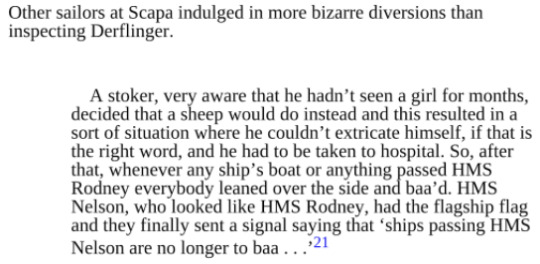
39 notes
·
View notes
Photo

El Más Letal: El Submarino I-19 Un submarino japonés, el I-19, asentaría en la historia submarina de la Segunda Guerra Mundial merecer el crédito por la mayor devastación causada en un solo ataque. La fecha era el 15 de septiembre de 1942. La armada de los Estados Unidos dirigía un gran convoy para apoyar a los elementos de la 1° División de Infantería de Marina en Guadalcanal. El portaaviones USS Wasp (CV 7) estaba entre la fuerza de escolta, que incluía al acorazado USS North Carolina (BB 55), los cruceros USS Helena (CL 50) y USS Salt Lake City (CA 25), y varios destructores, incluyendo el USS Laffey (DD 459) y USS O'Brien (DD 415). El diseño del portaaviones “Wasp” había sido dictado por los límites impuestos por el Tratado Naval de Washington de 1921. En esencia, era un diseño de la clase Yorktown a escala reducida, que desplazaba aproximadamente 14 900 toneladas en comparación con las 20 100 toneladas de Yorktown (CV 5), Enterprise (CV 6) y Hornet (CV 8). En el momento de la campaña de Guadalcanal, el “Wasp” transportaba 25 F4F Wildcats, 26 SBD Dauntless y 9 TBF Avengers. Según el “Dictionary of American Naval Fighting Ships”, el sumergible japonés I-19 inició su ataque alrededor de las 2:44 pm, disparando una ronda seis torpedos. Tres golpearon al Wasp por proa, golpeando los estancos donde se almacenaban combustible para los aviones y municiones. Los torpedos hirieron fatalmente al portaaviones. En detalle: dos de estos torpedos impactaron el punto bajo del portaviones a babor, cerca del combustible almacenado de la aviación. El tercero impacta en la parte más alta ascendente de la línea de flotación cerca de los recipientes que reaprovisionaban el sistema de combustible, causando un daño importante. Tales golpes directos hicieron inmediatamente el combustible de la aviación encender, por lo tanto, conduciendo a un incendio incontrolable. Tras estos daños el capitán del USS Wasp (CV -7) dio oficialmente la orden de abandonar la nave. Posteriormente se le ordenó al destructor USS Lansdowne hundir la nave completamente, objetivo el cual era únicamente evitar que esta cayera en manos de los japoneses. En la acción perdieron la vida 193 personas. https://www.instagram.com/p/B5_bAPbgKxi/?igshid=ovr27z9oaa8l
0 notes
Photo

1 350 4065 - USS Salt Lake City CA-25 - Resin Model Kit
$250
BUY IT NOW
0 notes
Photo

March 26th, 1943 - During the Battle of Komandorski Islands, Task Group 16.6, commanded by Rear Adm. Charles H. McMorris, prevents Japanese reinforcements from reaching Kiska, Aleutian Islands. USS Salt Lake City (CA 25) is damaged by gunfire from Japanese heavy cruisers, but damages one with return fire. #navyhistoryoftheday
0 notes
Photo

US Navy heavy cruisers USS Salt Lake City (CA-25), USS Pensacola (CA-24) and USS New Orleans (CA-32) (left to right) nested together at Pearl Harbor, 31 October 1943.
22 notes
·
View notes
Text
North American B-25B Mitchells taking off from USS Hornet (CV-8) for the Doolittle Raid on Toyko.
Filmed from USS Salt Lake City (CA-25) on April 18, 1942.
NARA: 79333
#USS Hornet (CV-8)#USS Hornet#Yorktown Class#Aircraft Carrier#USS Salt Lake City (CA-25)#USS Salt Lake City#Pensacola Class#Cruiser#April#1942#doolittle raid#Tokyo Raid#B-25#North American B-25 Mitchell#Bomber#united states navy#us navy#navy#usn#u.s. navy#World War II#World War 2#WWII#WW2#WWII History#History#military#pacific ocean#video#my post
439 notes
·
View notes
Text

USS IDAHO (BB-42) and USS SALT LAKE CITY (CA-25) fires on Japanese positions, during the Okinawa Operation
Photographed sometime between March and May 1945.
U.S. Naval History and Heritage Command: 80-G-K-5751
#USS Idaho (BB-42)#USS Idaho#New Mexico Class#dreadnought#battleship#USS Salt Lake City (CA-25)#USS Salt Lake City#Pensacola Class#Cruiser#March#May#1945#Okinawa#united states navy#us navy#navy#usn#u.s. navy#World War II#World War 2#WWII#WW2#WWII History#history#military history#military#color photo#my post
181 notes
·
View notes
Text

Launch of USS SALT LAKE CITY (CL-25) at the New York Shipbuilding Corporation, Camden, New Jersey on January 23, 1929.
"The modern shipbuilder has found that electric equipment is essential for the construction and reconditioning of every type of ship, from the smallest to the largest."
"Electricity - Builder of Ships" by Walter L. Greene in October 1935, commissioned by General Electric.
LIFE Magazine Archives: link
#USS Salt Lake City (CL-25)#USS Salt Lake City (CA-25)#USS Salt Lake City#Pensacola Class#Cruiser#launch#ship construction#January#1929#united states navy#us navy#navy#usn#u.s. navy#painting#my post
51 notes
·
View notes
Text

Yard workers cleaning the hull of USS Salt Lake City (CA-25). She was in Dry Dock at the Philadelphia Navy Yard, Pennsylvania, on October 21, 1931.
"The Salt Lake City, one of two heavy U.S. cruisers which have arrived in Brisbane, Australia, on a training cruise. The ship, built in Camden, is pictured at Philadelphia Navy Yard when it was undergoing repairs sometime ago."
Temple University Library: P563146B
#USS Salt Lake City (CA-25)#USS Salt Lake City#Pensacola Class#Cruiser#warship#ship#boat#Philadelphia Navy Yard#Pennsylvania#Philadelphia#drydock#dry dock#east coast#October#1931#interwar period#united states navy#us navy#navy#usn#u.s. navy#my post
33 notes
·
View notes
